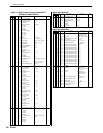
338 RS7000
12. Glossary
Multi-timbral Tone Generator
A tone generator that can simultaneously produce more
than one type of sound.
Mute
A function that temporarily silences a specified track.
N
Normalize
The process of maximizing the overall level of a sample
by increasing the amplitude of the waveform so that the
highest peak level is just below clipping.
Normal Voice
A voice which play normally via the keyboard with the
standard pitches for each key.
Note On/Off
MIDI messages which represent notes played on a key-
board or other instrument. Pressing a key produces a
Note On message, and a Note Off message is pro-
duced when the key is released.
NRPN
An acronym for Non Registered Parameter Number.
These are a type of MIDI control change message, and
are used to edit sounds via MIDI, allowing you to edit fil-
ter or EG settings, or adjust the pitch or level for each
instrument of a drum voice.
O
Offset Edit
A type of editing in which the value of a parameter is not
changed directly, rather a specified “offset” value is
added to or subtracted from the current parameter
value.
OPTICAL IN/OUT Connector
Optical connectors for input and output of digital audio
signals.
Optimize
The process of “de-fragmenting” the sample memory so
that the largest possible contiguous segment of mem-
ory is available for sampling.
Overdub
A method of real-time recording in which new material
is recorded without erasing previously recorded data.
P
Pan
The parameter that sets the stereo location of a sound
when it is played back in stereo. The pan parameters
found in the MIXER, VOICE EDIT, and other modes.
Parameter
A setting or data item which you can edit in the various
mode and sub mode displays.
Parameter Change
A MIDI system exclusive message which can be used
to adjust internal parameter settings. Refer to the MIDI
Data Format section for details.
Part
A single voice played via one of the 16 available MIDI
channels is known as a “part”. The RS7000 has 16
parts.
Partition
A software division on a disk storage medium (hard disk
or MO, for example) used to store data.
Pattern
This term covers a wide range of performance data that
can be recorded and played in the PATTERN mode.
Patterns can be repeated and switched to create the
desired musical flow. Patterns consist of from 1 to 16
phrases assigned to the pattern mode sequence tracks.
Pattern Chain
A number of patterns played in sequence (“chained”) to
create a complete song. The PATTERN CHAIN mode
automates the process of switching styles and sections.


















